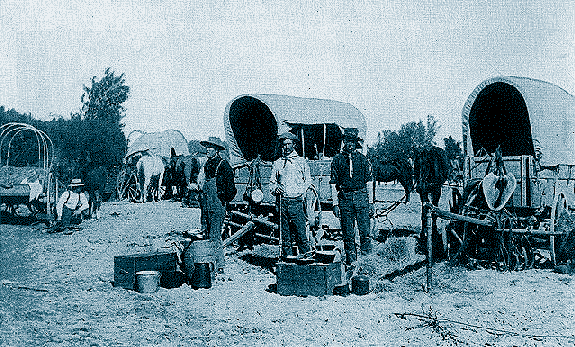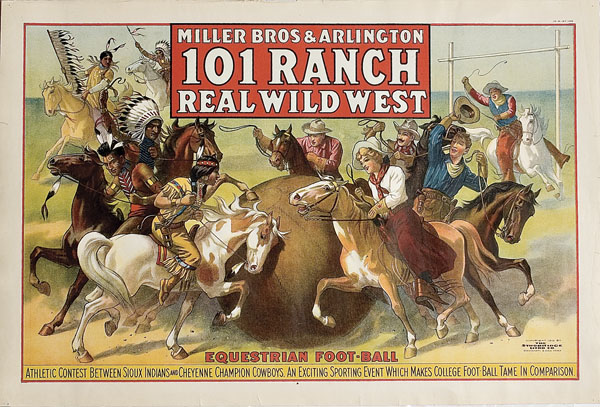Above: Ponca City street scene circa 1910. Photograph part of Library of Congress collection, donated by Charles M. Morgan (copyright expired).


|
The first white settlement in present day Oklahoma is generally considered to be in Kay County at Ferdinandina, which was probably named after King Ferdinand VI of Spain. Kay County is the also the location of the Miller Brothers' famed 101 Ranch, the "palace on the prairie" Marland Mansion, a statue selected by voting nationwide (the Pioneer Woman Statue and Museum), and a man-made lake, Kaw Lake, as well as being part of the Cherokee Outlet which was opened for white settlement on September 16, 1893, and portrayed in the films Tumbleweeds (1925) and Far and Away (1992).
Prior to the Cherokee Outlet run, this land had been divided into seven counties and assigned the letters K-Q as temporary names with Kay County assigned the letter “K”. These initial counties became Kay, Grant, Woods, Woodward, Garfield, Noble, and Pawnee after the run, when these communities sprang into existence and had elections to rename the counties.

Entrants awaiting the signal to start the land run. Photo by Walter D.
Hutchison and part of the Library of Congress (copyright expired).
Prior to the land run and due to its alliance during the Civil War with the Confederacy, the Cherokee, as part of the Reconstruction Treaties in 1866, agreed to sell part of its land to allow the federal government to bring other tribes to the outlet.
In 1873 the Kaw settled in northeastern Kay County. In 1877 the Ponca were removed from Nebraska to the area. Two years later the Nez Perce were brought from the Pacific Northwest to a reservation near present day Tonkawa. While at the Nez Perce Reservation, the tribe farmed and started schools. Many died during this short period of residence in Kay County, including the daughter of Chief Joseph.
The Nez Perce returned to their homeland in 1885 and the Tonkawa and Lipan Apache then occupied the former's reservation. In 1884, the Chilocco Indian School, a boarding school established by the federal government in the nineteenth century, opened.
Kay County includes two seventeenth and eighteenth century sites where the French and Spanish traded with the Wichita, bringing European goods to the area and moving meat, tallow, and hides of bison, deer, and bear to New Orleans: the Bryson-Paddock Site and the Deer Creek Site, both in the general vicinity of Newkirk.

Advertisement by The Strobridge Litho Co., 1918 (copyright expired).
At the turn of the twentieth century, the 101 Ranch was one of the largest diversified ranches in the United States boasting the 101 Ranch Wild West Show, which began its national tours in 1907 and went abroad in 1908. Over the course of the show's history, its cast included Lillian Smith, Bill Pickett, Bessie Herberg, Bee Ho Gray, Tom Mix, Jack Hoxie, Mexican Joe, Ross Hettan, and Buffalo Bill. |
.gif)
Links to web sites that are not part of The US GenWeb Project are provided for your convenience and do not imply any endorsement of the web sites or their contents by The US GenWeb Project.
|


